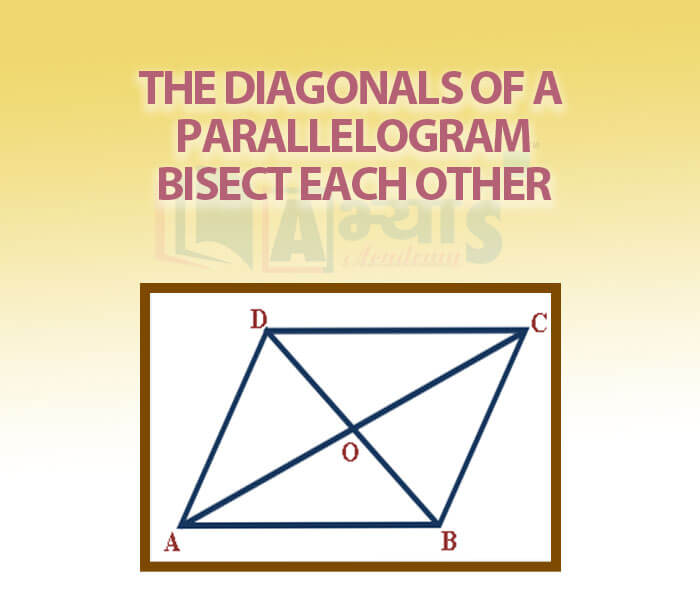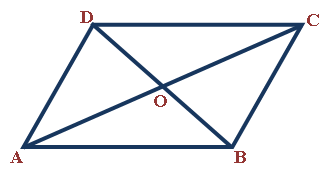The Diagonals of a Parallelogram Bisect Each Other













The Diagonals of a Parallelogram Bisect Each Other
Theorem 4: The diagonals of a parallelogram bisect each other. GIVEN A parallelogram ABCD such that its disgonal AC and BD intersect at O. To Prove OA = OC and OB = OD Proof Since ABCD is a parallelogram. Therefore, AB Now, AB
Again, AB
Now, in <BAO = DCO [From (i)] AB = CD [ and, <ABO = <CDO [From (ii)] So, by ASA congruence criterion
Hence, OA = OC and OB = OD |  |
| Converse Theorem: If the diagonals of a quadrilateral bisect each other, then the quadrilateral is a parallelogram | |
| Given: A quadrilateral ABCD in which the diagonals AC and BD intersect at O such that they bisect each other that is OA = OC and OB = OD | |
To Prove: The Quadrilateral ABCD is a Parallelogram Proof: In OA = OC [Given ]
OB = OD [Given] Therfore But they are alternate interior angles when AB and CD are straight lines and AC is the transversal As they are equal AB || CD Similarly we can prove that AD || BC As both the opposite pair of sides are parallel to each other. Hence ABCD is a parallelogram |  |
Illustration: In a parallelogram ABCD the diagonals AC and BD intersect at O, AC = 12.6 cm and BD = 5.8 cm. Find the length of OA, OB, OC and OD.
Solution: ABCD is a parallelogram and diagonals of the parallelogram bisect each other. O is the midpoint of AC OC = OA = 6.3 cm Similarly O is the mid point of BD OD = OB = 2.9 cm Hence OA = 6.3 cm, OB = 2.9cm, OC = 6.3 cm and OD = 2.9cm |  |
Students / Parents Reviews [10]
My experience with Abhyas is very good. I have learnt many things here like vedic maths and reasoning also. Teachers here first take our doubts and then there are assignments to verify our weak points.

Shivam Rana
7thMy experience with Abhyas academy is very good. I did not think that my every subject coming here will be so strong. The main thing is that the online tests had made me learn here more things.

Hiya Gupta
8thOne of the best institutes to develope a child interest in studies.Provides SST and English knowledge also unlike other institutes. Teachers are co operative and friendly online tests andPPT develope practical knowledge also.

Aman Kumar Shrivastava
10thIt was good as the experience because as we had come here we had been improved in a such envirnment created here.Extra is taught which is beneficial for future.

Eshan Arora
8thA marvelous experience with Abhyas. I am glad to share that my ward has achieved more than enough at the Ambala ABHYAS centre. Years have passed on and more and more he has gained. May the centre flourish and develop day by day by the grace of God.

Archit Segal
7thAbout Abhyas metholodology the teachers are very nice and hardworking toward students.The Centre Head Mrs Anu Sethi is also a brilliant teacher.Abhyas has taught me how to overcome problems and has always taken my doubts and suppoeted me.

Shreya Shrivastava
8thBeing a parent, I saw my daughter improvement in her studies by seeing a good result in all day to day compititive exam TMO, NSO, IEO etc and as well as studies. I have got a fruitful result from my daughter.

Prisha Gupta
8thI have spent a wonderful time in Abhyas academy. It has made my reasoning more apt, English more stronger and Maths an interesting subject for me. It has given me a habbit of self studying

Yatharthi Sharma
10thIt has a great methodology. Students here can get analysis to their test quickly.We can learn easily through PPTs and the testing methods are good. We know that where we have to practice

Barkha Arora
10thAbhyas is a complete education Institute. Here extreme care is taken by teacher with the help of regular exam. Extra classes also conducted by the institute, if the student is weak.
